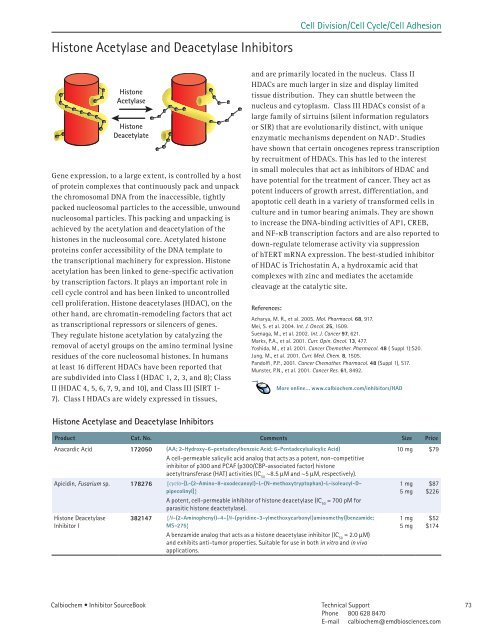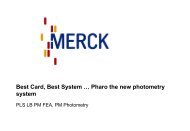Inhibitor SourceBook™ Second Edition
Inhibitor SourceBook™ Second Edition
Inhibitor SourceBook™ Second Edition
Create successful ePaper yourself
Turn your PDF publications into a flip-book with our unique Google optimized e-Paper software.
Histone Acetylase and Deacetylase <strong>Inhibitor</strong>s<br />
Gene expression, to a large extent, is controlled by a host<br />
of protein complexes that continuously pack and unpack<br />
the chromosomal DNA from the inaccessible, tightly<br />
packed nucleosomal particles to the accessible, unwound<br />
nucleosomal particles. This packing and unpacking is<br />
achieved by the acetylation and deacetylation of the<br />
histones in the nucleosomal core. Acetylated histone<br />
proteins confer accessibility of the DNA template to<br />
the transcriptional machinery for expression. Histone<br />
acetylation has been linked to gene-specific activation<br />
by transcription factors. It plays an important role in<br />
cell cycle control and has been linked to uncontrolled<br />
cell proliferation. Histone deacetylases (HDAC), on the<br />
other hand, are chromatin-remodeling factors that act<br />
as transcriptional repressors or silencers of genes.<br />
They regulate histone acetylation by catalyzing the<br />
removal of acetyl groups on the amino terminal lysine<br />
residues of the core nucleosomal histones. In humans<br />
at least 16 different HDACs have been reported that<br />
are subdivided into Class I (HDAC 1, 2, 3, and 8); Class<br />
II (HDAC 4, 5, 6, 7, 9, and 10), and Class III (SIRT 1-<br />
7). Class I HDACs are widely expressed in tissues,<br />
Histone Acetylase and Deacetylase <strong>Inhibitor</strong>s<br />
Calbiochem • <strong>Inhibitor</strong> SourceBook<br />
Cell Division/Cell Cycle/Cell Adhesion<br />
and are primarily located in the nucleus. Class II<br />
HDACs are much larger in size and display limited<br />
tissue distribution. They can shuttle between the<br />
nucleus and cytoplasm. Class III HDACs consist of a<br />
large family of sirtuins (silent information regulators<br />
or SIR) that are evolutionarily distinct, with unique<br />
enzymatic mechanisms dependent on NAD + . Studies<br />
have shown that certain oncogenes repress transcription<br />
by recruitment of HDACs. This has led to the interest<br />
in small molecules that act as inhibitors of HDAC and<br />
have potential for the treatment of cancer. They act as<br />
potent inducers of growth arrest, differentiation, and<br />
apoptotic cell death in a variety of transformed cells in<br />
culture and in tumor bearing animals. They are shown<br />
to increase the DNA-binding activities of AP1, CREB,<br />
and NF-kB transcription factors and are also reported to<br />
down-regulate telomerase activity via suppression<br />
of hTERT mRNA expression. The best-studied inhibitor<br />
of HDAC is Trichostatin A, a hydroxamic acid that<br />
complexes with zinc and mediates the acetamide<br />
cleavage at the catalytic site.<br />
References:<br />
Acharya, M. R., et al. 2005. Mol. Pharmacol. 68, 9 7.<br />
Mei, S. et al. 2004. Int. J. Oncol. 25, 509.<br />
Suenaga, M., et al. 2002. Int. J. Cancer 97, 62 .<br />
Marks, P.A., et al. 200 . Curr. Opin. Oncol. 13, 477.<br />
Yoshida, M., et al. 200 . Cancer Chemother. Pharmacol. 48 ( Suppl ):S20.<br />
Jung. M., et al. 200 . Curr. Med. Chem. 8, 505.<br />
Pandolfi, P.P., 200 . Cancer Chemother. Pharmacol. 48 (Suppl ), S 7.<br />
Munster, P.N., et al. 200 . Cancer Res. 61, 8492.<br />
Product Cat. No. Comments Size Price<br />
Anacardic Acid 172050 (AA; 2-Hydroxy-6-pentadecylbenzoic Acid; 6-Pentadecylsalicylic Acid)<br />
A cell-permeable salicylic acid analog that acts as a potent, non-competitive<br />
inhibitor of p300 and PCAF (p300/CBP-associated factor) histone<br />
acetyltransferase (HAT) activities (IC 50 ~8.5 mM and ~5 mM, respectively).<br />
Apicidin, Fusarium sp. 178276 {cyclo-[L-(2-Amino-8-oxodecanoyl)-L-(N-methoxytryptophan)-L-isoleucyl-Dpipecolinyl]}<br />
Histone Deacetylase<br />
<strong>Inhibitor</strong> I<br />
More online... www.calbiochem.com/inhibitors/HAD<br />
A potent, cell-permeable inhibitor of histone deacetylase (IC 50 = 700 pM for<br />
parasitic histone deactetylase).<br />
382147 {N-(2-Aminophenyl)-4-[N-(pyridine-3-ylmethoxycarbonyl)aminomethyl]benzamide;<br />
MS-275}<br />
A benzamide analog that acts as a histone deacetylase inhibitor (IC 50 = 2.0 mM)<br />
and exhibits anti-tumor properties. Suitable for use in both in vitro and in vivo<br />
applications.<br />
0 mg $79<br />
mg<br />
5 mg<br />
mg<br />
5 mg<br />
$87<br />
$226<br />
$52<br />
$ 74<br />
Technical Support<br />
Phone 800 628 8470<br />
E-mail calbiochem@emdbiosciences.com<br />
73



